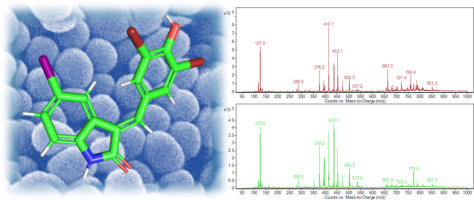当前位置:
X-MOL 学术
›
J. Proteomics
›
论文详情
Our official English website, www.x-mol.net, welcomes your
feedback! (Note: you will need to create a separate account there.)
Proteomic analysis of bacterial response to a 4-hydroxybenzylidene indolinone compound, which re-sensitizes bacteria to traditional antibiotics.
Journal of Proteomics ( IF 2.8 ) Pub Date : 2019-04-25 , DOI: 10.1016/j.jprot.2019.04.018 Clement Opoku-Temeng 1 , Kenneth Ikenna Onyedibe 2 , Uma K Aryal 3 , Herman O Sintim 2
Journal of Proteomics ( IF 2.8 ) Pub Date : 2019-04-25 , DOI: 10.1016/j.jprot.2019.04.018 Clement Opoku-Temeng 1 , Kenneth Ikenna Onyedibe 2 , Uma K Aryal 3 , Herman O Sintim 2
Affiliation

|
Halogenated 4-hydroxybenzylidene indolinones have been shown to re-sensitize methicillin-resistant Staphylococcus aureus (MRSA) and vancomycin-resistant Enterococcus faecalis (VRE) to methicillin and vancomycin respectively. The mechanism of antibiotic re-sensitization was however not previously studied. Here, we probe the scope of antibiotic re-sensitization and present the global proteomics analysis of S. aureus treated with GW5074, a 4-hydroxybenzylidene indolinone compound. With a minimum inhibitory concentration (MIC) of 8 μg/mL against S. aureus, GW5074 synergized with beta-lactam antibiotics like ampicillin, carbenicillin and cloxacillin, the DNA synthesis inhibitor, ciprofloxacin, the protein synthesis inhibitor, gentamicin and the folate acid synthesis inhibitor, trimethoprim. Global proteomics analysis revealed that GW5074 treatment resulted in significant downregulation of enzymes involved in the purine biosynthesis. S. aureus proteins involved in amino acid metabolism and peptide transport were also observed to be downregulated. Interestingly, anti-virulence targets such as AgrC (a quorum sensing-related histidine kinase), AgrA (a quorum sensing-related response regulator) as well as downstream targets, such as hemolysins, lipases and proteases in S. aureus were also downregulated by GW5074. We observed that the peptidoglycan hydrolase, SceD was significantly upregulated. The activity of GW5074 on S. aureus suggests that the compound primes bacteria for the antibacterial action of ineffective antibiotics. SIGNIFICANCE: Antibiotic resistance continues to present significant challenges to the treatment of bacterial infections. Given that antibiotic resistance is a natural phenomenon and that it has become increasingly difficult to discover novel antibiotics, efforts to improve the activity of existing agents are worth pursuing. A few small molecules that re-sensitize resistant bacteria to traditional antibiotics have been described but the molecular details that underpin how these compounds work to re-sensitize bacteria remain largely unknown. In this report, global label-free quantitative proteomics was used to identify changes in the proteome that occurs when GW5074, a compound that re-sensitize MRSA to methicillin, is administered to S. aureus. The identification of pathways that are impacted by GW5074 could help identify novel targets for antibiotic re-sensitization.
中文翻译:

蛋白质组学分析细菌对4-羟基亚苄基吲哚酮化合物的反应,该化合物可使细菌重新敏感于传统抗生素。
卤代的4-羟基亚苄基吲哚酮已被证明分别使耐甲氧西林的金黄色葡萄球菌(MRSA)和耐万古霉素的粪便肠球菌(VRE)分别对甲氧西林和万古霉素敏感。然而,抗生素再敏化的机理以前没有被研究过。在这里,我们探讨了抗生素再敏化的范围,并介绍了用4-羟基亚苄基吲哚酮化合物GW5074处理的金黄色葡萄球菌的蛋白质组学分析。GW5074对金黄色葡萄球菌的最低抑菌浓度(MIC)为8μg/ mL,可与β-内酰胺抗生素(如氨苄西林,羧苄青霉素和氯西林,DNA合成抑制剂,环丙沙星,蛋白质合成抑制剂,庆大霉素和叶酸合成)协同作用抑制剂甲氧苄氨嘧啶。全球蛋白质组学分析表明,GW5074处理导致嘌呤生物合成中涉及的酶显着下调。还观察到参与氨基酸代谢和肽转运的金黄色葡萄球菌蛋白被下调。有趣的是,金黄色葡萄球菌中的抗毒力靶标(例如AgrC(群体感应相关的组氨酸激酶),AgrA(群体感应相关响应调节剂)以及下游靶标(例如溶血素,脂肪酶和蛋白酶)也被下调了。 GW5074。我们观察到,肽聚糖水解酶SceD明显上调。GW5074对金黄色葡萄球菌的活性表明,该化合物可引发细菌对无效抗生素的抗菌作用。意义:抗生素耐药性继续对细菌感染的治疗提出重大挑战。鉴于抗生素耐药性是自然现象,并且发现新型抗生素变得越来越困难,因此有必要努力改善现有药物的活性。已经描述了一些使抗药性细菌对传统抗生素重新敏感的小分子,但是支撑这些化合物如何对细菌重新敏感的分子细节仍然未知。在本报告中,使用了无标签的全球定量蛋白质组学来鉴定将金黄色葡萄球菌对MRSA重新敏感的GW5074(一种使MRSA对甲氧西林重新敏感的化合物)发生时蛋白质组的变化。
更新日期:2019-04-25
中文翻译:

蛋白质组学分析细菌对4-羟基亚苄基吲哚酮化合物的反应,该化合物可使细菌重新敏感于传统抗生素。
卤代的4-羟基亚苄基吲哚酮已被证明分别使耐甲氧西林的金黄色葡萄球菌(MRSA)和耐万古霉素的粪便肠球菌(VRE)分别对甲氧西林和万古霉素敏感。然而,抗生素再敏化的机理以前没有被研究过。在这里,我们探讨了抗生素再敏化的范围,并介绍了用4-羟基亚苄基吲哚酮化合物GW5074处理的金黄色葡萄球菌的蛋白质组学分析。GW5074对金黄色葡萄球菌的最低抑菌浓度(MIC)为8μg/ mL,可与β-内酰胺抗生素(如氨苄西林,羧苄青霉素和氯西林,DNA合成抑制剂,环丙沙星,蛋白质合成抑制剂,庆大霉素和叶酸合成)协同作用抑制剂甲氧苄氨嘧啶。全球蛋白质组学分析表明,GW5074处理导致嘌呤生物合成中涉及的酶显着下调。还观察到参与氨基酸代谢和肽转运的金黄色葡萄球菌蛋白被下调。有趣的是,金黄色葡萄球菌中的抗毒力靶标(例如AgrC(群体感应相关的组氨酸激酶),AgrA(群体感应相关响应调节剂)以及下游靶标(例如溶血素,脂肪酶和蛋白酶)也被下调了。 GW5074。我们观察到,肽聚糖水解酶SceD明显上调。GW5074对金黄色葡萄球菌的活性表明,该化合物可引发细菌对无效抗生素的抗菌作用。意义:抗生素耐药性继续对细菌感染的治疗提出重大挑战。鉴于抗生素耐药性是自然现象,并且发现新型抗生素变得越来越困难,因此有必要努力改善现有药物的活性。已经描述了一些使抗药性细菌对传统抗生素重新敏感的小分子,但是支撑这些化合物如何对细菌重新敏感的分子细节仍然未知。在本报告中,使用了无标签的全球定量蛋白质组学来鉴定将金黄色葡萄球菌对MRSA重新敏感的GW5074(一种使MRSA对甲氧西林重新敏感的化合物)发生时蛋白质组的变化。






























 京公网安备 11010802027423号
京公网安备 11010802027423号